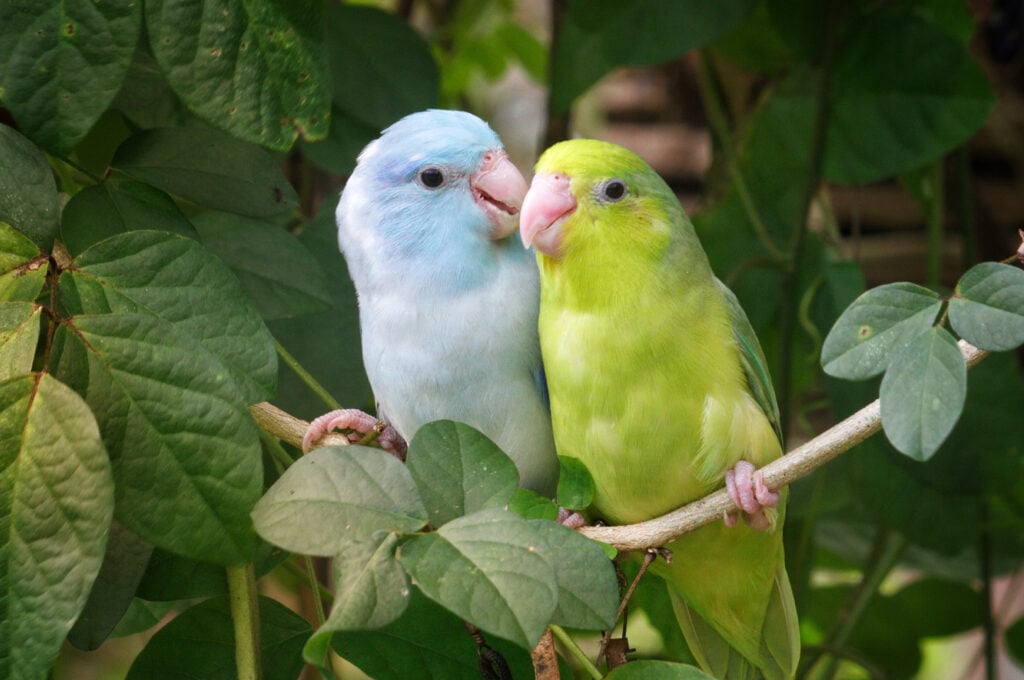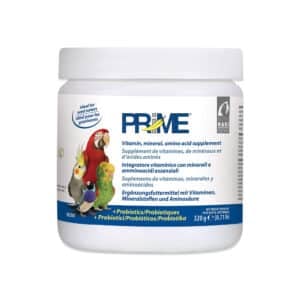Your cart is currently empty!
HARI Official Brand Site
Common Species
Pacific Parrotlet (Forpus coelestis)
Origin/Habitat
Mexico, Middle & South America
Tiny Parrots. Big Personalities.
Parrotlets are best described as fun, energetic, and affectionate. Their playful, sprightly nature make great pets for someone who wants a mini-parrot! They are also remarkably affectionate. A well-socialized parrotlet will seek attention and cuddle with its favorite human. Despite their small size, they share many physical and behavioral characteristics with larger parrots, and are even closely related to Amazon parrots. They are typically quiet and, with proper training, can learn to imitate human speech and whistle. They are small enough to live comfortably in smaller homes and apartments, but they are also large enough to provide plenty of entertainment. However, they require sufficient mental and physical exercise to prevent them from becoming bored and subsequently, destructive.
Parrotlet species originate in Mexico, Middle & South America and find security in large flocks.
There are several species of Parrotlets, but the most common pet species being the Pacific Parrotlet. Lesser known species of Parrotlets include Mexican Parrotlet (Forpus Cyanopygius) and Green Rumped (Forpus passerinus).
Health Booklet
Keeping track of bird health by recording their growth, development, behavior and environment in a booklet can help ensure that your companion parrot will be healthy and happy for many years to come.
Physical Description
Parrotlets are predominantly green birds with short tails. Pacific Parrotlets are stocky little birds with short, wide beaks and short pointed tails. While the standard Pacific Parrotlet will have slight blue feathers above the eye and bright green feathers on the face, there are a few exciting mutations to include blue, yellow, or other colors. Their eyes are dark brown in color.


Pacific Parrotlets average weight is 31-34 g (1.1-1.2 oz) with size measurement of 12.5 cm (5 inches).
Sex
When identifying the gender of adult Pacific Parrotlets, it’s important to look for certain visual cues. Male Parrotlets typically have more intense green feathers on their face, blue wing covert feathers, and a blue line of feathers above their eye. Additionally, they may have blue feathers on their rump. Females, on the other hand, have more subdued coloring with emerald-green feathers replacing the blue found on males. Similar visual differences can be observed in other Parrotlet species. It may be more difficult to determine the sex of immature birds, but with experience, it can be done.

Personality Traits & Behaviors
Parrotlets are cute little birds known for being super friendly, energetic, and curious. Although, sometimes they can get a little aggressive, so it’s important to spend time with them and keep them entertained.

Noise Level/Speech/Song
Parrotlets have the ability to learn a limited vocabulary of words and phrases, which they can repeat back to their owners. Compared to other parrot species, they are generally considered to be quieter and less vocal, making them ideal pets for those who live in apartments or small homes.

Intelligence & Learning
Parrotlets are generally recognized as intelligent birds that can learn tricks and imitate human speech to a certain degree. They have even been observed using tools in their natural habitat, which is a strong indication of their intelligence. Beyond this, they have a great deal of curiosity and skill in solving problems.

Threats/Conservation
There is little concern with wild populations of Pacific Parrotlets, but some Parrotlet species not commonly found in the companion pet populations are threatened due to habitat loss.

Relationship with Humans
Parrotlets are super friendly little birds that just love hanging out with people. They need a lot of interaction with their human friends to be happy and healthy. If they don’t get enough attention, it can really affect their mood and behavior.
Care
The general rule of thumb when buying a bird cage is to buy the largest cage you can afford. For optimum health and safety, the cage should be at least two and a half times the width of the birds’ wingspan in all directions. Cage bar spacing should never be so wide that your bird could stick his head through, and his tail feathers should not be able to touch the bars when he is perched comfortably. Also consider your bird’s beak strength to determine the proper gauge of the bars as some birds have been known to bend the bars and escape.
A rectangular cage with horizontal bars in which your bird has plenty of room to climb and play is the best environment for your parrot. Your parrot will be happiest in a well-ventilated room with as much natural light as possible, yet away from direct sunlight and drafts. Your bird will want to be part of the action but not right in the middle of it. Avoid placing your bird’s cage in the kitchen as there are many hazards including vapors from heated PTFE coated pans (PTFE is better known as TeflonTM), hot stoves, pots of boiling water, and cooking fumes all of which can be very harmful to your bird. The cage and accessories should be thoroughly cleaned and disinfected weekly. Make sure your bird stays healthy by providing them with fresh food and water every day. Don’t forget to wash their dishes daily!
Time out of the cage every day for socialization and exercise is important. Parrots enjoy supervised activities on a play gym loaded with their favorite toys and enrichment food. Make sure he does not have access to open doors or windows, toilets with the lid up, hot stoves, moving ceiling fans or large panes of glass. It’s also a good idea to ensure he does not chew on or ingest anything unsafe such as treated or painted wood or unsafe house plants. Do not keep your bird in a room where sprays such as perfume, hair spray, air fresheners or aerosol sprays are used frequently.
For the safety of your beloved parrot, we advise against leaving them unattended with other pets like dogs, cats, or ferrets.
When it comes to feeding your Parrotlet there are countless opinions to consider. Here’s what we believe: a high-quality extruded diet – such as Tropican – serves as the foundation of your parrot’s diet, while other healthy enrichment foods provide welcome variety.
Pelleted bird food is the ideal source of nutrition to keep your parrot healthy. However, it’s important to offer variety, too, gourmet seeds, dried fruits, vegetables, and nuts (such as Tropimix), beans, and fresh fruits and vegetables all provide essential nutrients and diversity to your parrot’s diet. Sensible, healthy table foods such as cooked pasta, rice, hard-boiled eggs, multigrain toast, and unsalted crackers can also serve as treats in small amounts.
It is crucial to avoid unhealthy people foods. Never feed your parrot chocolate, alcohol, caffeine beverages, or avocado as even small amounts can be toxic. Salty or sugary foods should also be avoided. Check out our feeding recommendations for most parrot species.
Of course, fresh water every day is very important too. Remember to wash and refill your parrot’s water bowl daily to keep your bird healthy and happy.
Parrotlets need ten to twelve hours of uninterrupted sleep per night. If your bird cage is normally situated in a room where there is a lot of activity or movement, it is best to move it to a secluded dark area at night. Sleep is a vital to a parrotlet’s well-being.
Many bird owners will cover the bird cage at night to help block out extra light (especially during the summertime). A cover can also keep the cage warmer (for those living in colder climates).
Placing a comfortable perch higher up in the cage will give them a sense of security and keep their feet healthy. If you do not plan on covering the cage or if the bird suffers from night terrors try using an infrared basking light or small night light in the room.
t’s important to maintain clean and appropriately sized perches to prevent Pododermatitis or Bumblefoot in your bird. Offer your bird at least three types of perches, such as cotton or sisal rope and natural wood perches. Remember to vary the diameter and size of the perches to fit your bird’s feet. Additionally, consider adding natural branches to the cage for perching and chewing. Opt for branches like willow, alder, ash, birch, or apple, but replace them every 4-6 weeks and remove the leaves.
Always keep your bird safe and comfortable by keeping their perches clean. Regularly inspect cotton or sisal rope perches for any signs of fraying or loose strands, and replace perches as needed due to normal wear and tear. If you use a grooming perch, place it on a lower level of the cage and away from food and water dishes.
It is important to provide your parrotlet with lots of different toys that encourage physical and foraging activity. Parrotlets love a variety of toys that include bells, ladders, and swings. If you’re unsure which toys are suitable, check out the HARI Smart.Play and HARI Active.Play toys, which are designed for birds of specific sizes and purposes.
Parrotlets can become “one-person” birds without socialization experience. It is recommended to spend equal time with all household members.
Consistent positive behavior training is a great way to bond with your Parrotlet parrot. It’s best to start training as early as possible and begin with basic commands, such as “step up” and “step down”. Use positive reinforcement techniques and praise to encourage good behavior. Training your bird on a stand with a favorite treat is an excellent way to utilize time away from their main cage.
Introducing your parrot to new situations is key in preventing fear and aggression towards strangers. Socialize your parrot by exposing them to different people, environments, toys, and foods. The more varied experiences your parrot has, the more comfortable and well-adjusted they will be.
In order to maintain the optimal health of parrotlets, it is recommended to regularly mist them. This helps to keep their skin and feathers in a healthy condition. Additionally, many parrotlets enjoy the act of bathing, and will often take advantage of a traditional bird bath if provided.
Whether or not to trim your parrot’s flight feathers is your decision, but many owners choose to do so. Trimming is a painless process that is similar to a regular haircut and should be done twice a year during the bird’s moulting period. It’s also important to regularly inspect and groom your bird’s toenails. To ensure the safety of your bird, it’s recommended that a professional bird groomer handle the trimming of your bird’s nails and wings. This will prevent any accidental cutting of a blood feather, which can be dangerous for your bird. Keep in mind that trimming wings is not a guaranteed way to prevent flight, as even a few grown-in feathers can give your bird flight ability. Therefore, it’s important to never take your bird outside unless they are in a secure cage or wearing a properly fitted bird harness.
The following is a list of common household dangers: Non-stick surfaces (like TeflonTM coated pans), oven cleaner and self-cleaning ovens, cigarette Smoke, paint and paint fumes, scented candles, household cleaners, floor polish, hairspray, chlorine bleach, perfume, aerosol sprays, nail polish and nail polish remover fumes and ingesting harmful or toxic house plants. It’s important to make sure everyone in the family is aware of food and other products in the home that are potentially toxic to parrotlets. Avocados, chocolate, coffee beans, onions, salt, and fruit seeds or pits should never be offered. Ceiling fans, cupboards, blinds and open doors & windows can also pose a risk as your pet may fly into, get trapped or simply fly away.
It’s important to keep an eye on your bird’s health and behavior since birds tend to hide signs of illness. For Parrotlets, it’s advisable to visit an avian vet or an exotic pet specialist for a thorough check-up and preventive health care plan at least once a year. When looking for a vet, choose one who specializes in bird and/or exotic pet species. Some clinics can handle routine bird appointments but may refer you to a certified avian vet for more complicated cases. An avian vet can offer expert guidance on proper health care for your bird.
Availability in the Pet Market
Most Parrotlets can be obtained from an avian specialty shop, pet dealer, or a reputable breeder. Online adoption organizations and rescues can also be a viable option for those looking to adopt a Parrotlet.
….

Aviculture
Breeding Habits
Parrotlets typically begin nesting in January and tend to produce two clutches before the start of the rainy season, which is usually around May. Each clutch typically contains 4-6 eggs, with the female primarily responsible for incubation. The average incubation period lasts approximately 17 days.
Parrotlets bred in aviaries can produce more clutches per year when provided with optimal conditions such as adequate food and a secure nesting box. It is crucial to ensure that adult birds are healthy and feel safe. While Parrotlets can start to reproduce at 12-13 months, most aviculturists recommend waiting until they are at least 18 months old before breeding.
Hatchling to Fledgling
Most aviculturists catering to the pet bird trade prefer to have parent birds raise their young for about two to three weeks before beginning hand-feeding. Breeding parrots should be in optimal health and receive proper nutrition to support the needs of both the “expectant” parents and the nestlings. Tropican High Performance 2mm, 4mm, 8mm, Sticks and Tropimix Small and Large Parrot are excellent options, as well as vegetables and fruits high in beta-carotene to meet the nutritional needs of breeding parrots. Adding Prime Vitamins to the diet can also benefit breeding pairs on a predominately seed-based diet.






